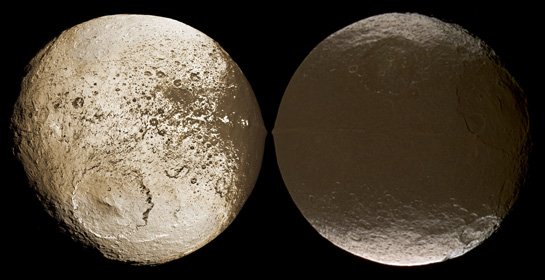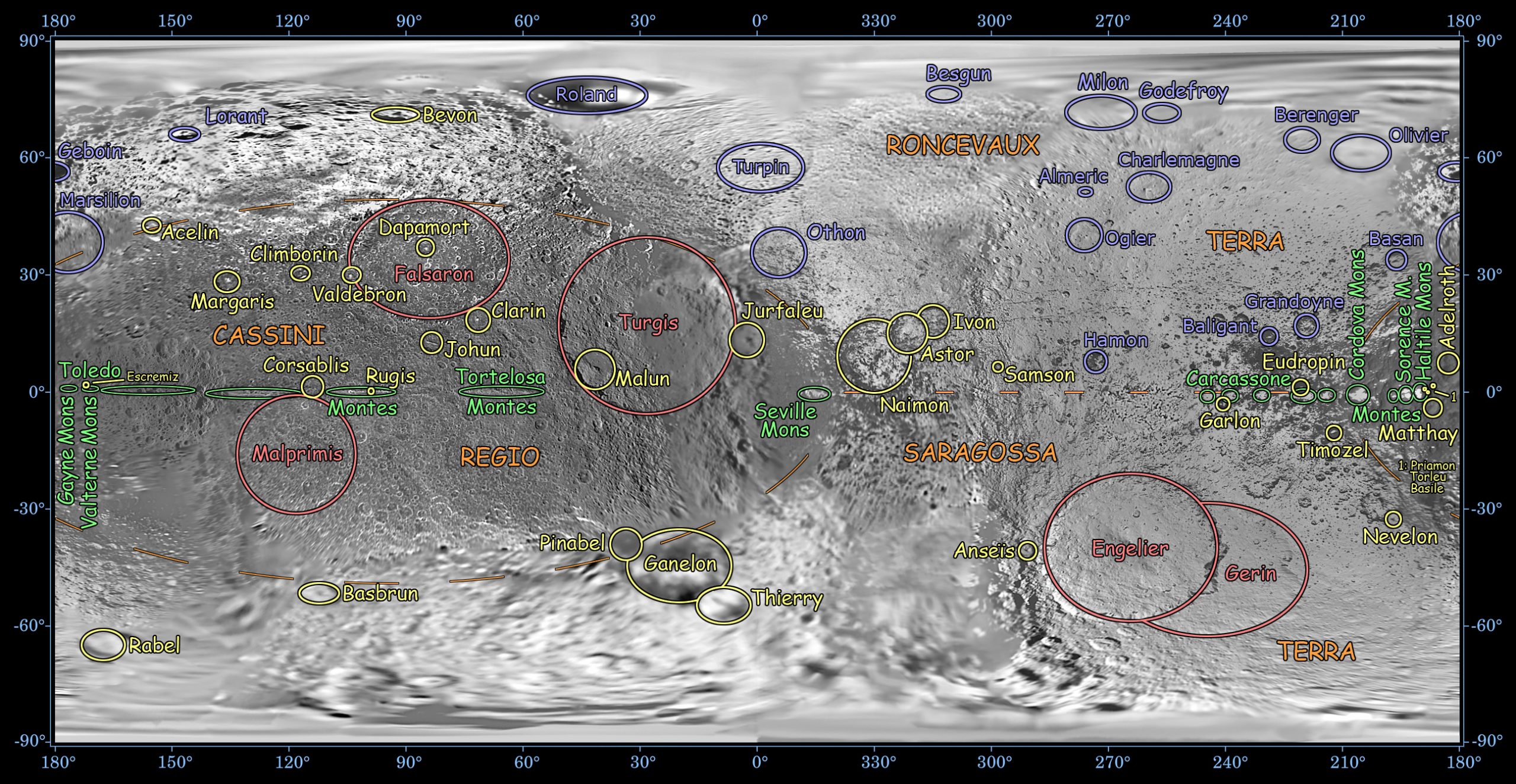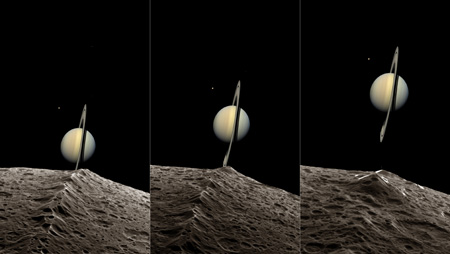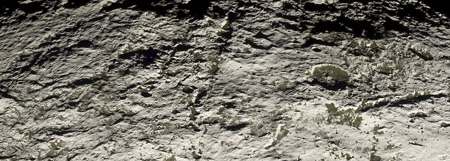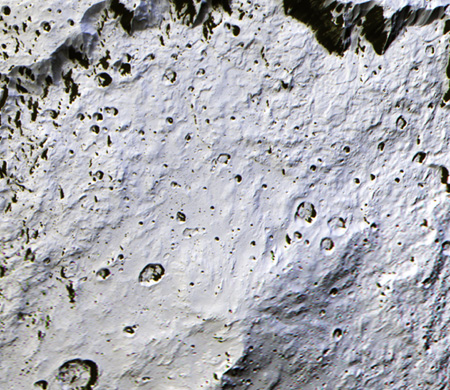| Iapetus is the outermost regular moon of Saturn. It has a diameter of almost 1500 kilometers. One of my responsibilities for Cassini was the imaging observation planning of Iapetus as well as the observation planning of the sole close flyby during the mission (“049IA“) at the end of orbit 49 on 10 Sep 2007.
The albedo dichotomy was already recognized in 1677 by Jean-Dominique Cassini, the discoverer of Iapetus. However, the physical reason remained mysterious over 330 years, until the Cassini spacecraft sent images and surface temperature data of Iapetus back to Earth. The giant ridge was discovered in Cassini images from 25 Dec 2004. Hints for unusual mountains were already seen in data obtained by the Voyager-2 spacecraft in 1981. This web site compiles a short history of Iapetus research through related publications and web posts. |
Iapetus ist der äußerste der sogenannten regulären Saturnmonde. Sein Durchmesser beträgt fast 1500 Kilometer. Während der Cassini-Mission war ich für die Kamera-Beobachtungsplanung dieses Mondes zuständig sowie für die Planung des einzigen nahen Vorbeiflugs an diesem Mond (“049IA“) am Ende von Orbit 49 am 10 Sep 2007.
Iapetus zeigt sehr viele ungewöhnliche Eigenschaften. Zwei davon sind: (1) Die globale Helligkeitsdichotomie, welche die Oberfläche global in eine sehr dunkle (fast so schwarz wie Kohle) und eine recht helle Seite (so hell wie nicht mehr ganz frischer Schnee) unterteilt; (2) ein gigantischer Bergrücken, der mehr als die Hälfte des Iapetus-Umfangs exakt am Äquator umspannt. Die Helligkeitsdichotomie war bereits von Jean-Dominique Cassini, dem Entdecker von Iapetus, im Jahr 1677 beschrieben worden. Die physikalische Ursache hingegen blieb über 330 Jahre mysteriös und konnte erst mit Bildern und Temperaturdaten der Cassini-Sonde enträtselt werden. Der Bergrücken wurde in Bildern vom 25 Dez 2004 entdeckt. Hinweise auf ungewöhnlich hohe Berge waren schon zuvor in Aufnahmen gefunden worden, die der Raumsonde Voyager-2 im Jahr 1981 gelangen. Diese Webseite bietet eine kurze Geschichte der Iapetus-Forschung. |
2010 — Iapetus Global Brightness Dichotomy Enigma Solved
The extreme albedo asymmetry of Iapetus, which is about 10x as bright on its trailing hemisphere as on its leading hemisphere, has been an enigma since 1677 (Cassini 1677, Phil. Trans.). Deposition of exogenic dark material on the leading side has been proposed as a cause (Soter 1974, talk at IAU Colloquium 28, but no abstract), but this alone cannot explain the global shape, sharpness, and complexity of the transition between Iapetus’s bright and dark terrain. Instead, all these characteristics, and the asymmetry’s large amplitude, can be explained by runaway global thermal migration of water ice, triggered by the deposition of dark material on the leading hemisphere. This mechanism is unique to Iapetus among the Saturnian satellites because its slow rotation produces unusually high daytime temperatures and water ice sublimation rates (from Spencer & Denk 2010, Science).
Why just Iapetus?
Peculiar Iapetus properties, in combination unique, are:
– Synchronous rotation → Iapetus has a “leading” and a “trailing” side.
– Extremely slow rotation (Psyn = 80 days!) → afternoon temperatures potentially warmer than on other places in the Saturn system.
– Large distance to Sun (9.5 au) → coldest and warmest temperatures on Iapetus just right for the mechanism to act.
– Very dark non-ice component near surface → helps to further increase the temperature → self-sustaining (“runaway”) sublimation of water ice.
– Relatively small (but not too small) size/gravity (1/43 of Earth’s g) → water ice migration acts on hemispheric scales (not so much on local scales, and only little water escapes into space).
– Outermost location in the regular satellite system of Saturn → retrograde dust from outer moons hits Iapetus’s leading side head-on; no dust “protection” by a big moon like Titan.
– Color dichotomy discovered (Denk et al. 2010, Science) → shows a pattern as is expected for dust from retrograde outer moons.
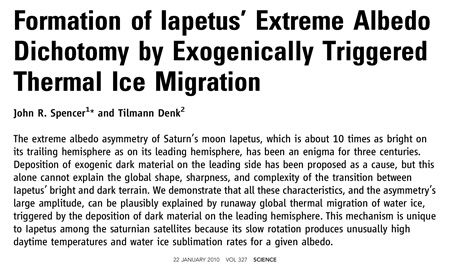 Science Magazine (22 Jan 2010):
Science Magazine (22 Jan 2010):
![]() Denk, T., Neukum, G., Roatsch, Th., Porco, C.C., Burns, J.A., Galuba, G.G., Schmedemann, N., Helfenstein, P., Thomas, P.C., Wagner, R.J., West, R.A. (2010): Iapetus: Unique Surface Properties and a Global Color Dichotomy from Cassini Imaging. Science 327, 435-439. doi:10.1126/science.1177088.
Denk, T., Neukum, G., Roatsch, Th., Porco, C.C., Burns, J.A., Galuba, G.G., Schmedemann, N., Helfenstein, P., Thomas, P.C., Wagner, R.J., West, R.A. (2010): Iapetus: Unique Surface Properties and a Global Color Dichotomy from Cassini Imaging. Science 327, 435-439. doi:10.1126/science.1177088.
![]() Spencer, J.R., Denk, T. (2010): Formation of Iapetus’s Extreme Albedo Dichotomy by Exogenically-Triggered Thermal Migration of Water Ice. Science 327, 432-435. doi:10.1126/science.1177132.
Spencer, J.R., Denk, T. (2010): Formation of Iapetus’s Extreme Albedo Dichotomy by Exogenically-Triggered Thermal Migration of Water Ice. Science 327, 432-435. doi:10.1126/science.1177132.
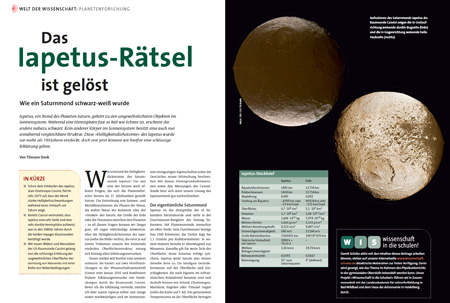 Sterne und Weltraum (April 2010):
Sterne und Weltraum (April 2010):
![]() Denk, T. (2010): Das Iapetus-Rätsel ist gelöst. Sterne und Weltraum 4/2010, S.40-49.
Denk, T. (2010): Das Iapetus-Rätsel ist gelöst. Sterne und Weltraum 4/2010, S.40-49.
Press release / Pressemitteilung Freie Universität Berlin (Dec 2009):
![]() 10Dec2009
10Dec2009 ![]() 10Dez2009.
10Dez2009.
2007 — Cassini’s Targeted Flyby of Iapetus
This article gives a comprehensive summary with a lot of inside information about the only Iapetus flyby of the Cassini spacecraft. This site has some details on what the spacecraft was doing during the flyby, and how the observation planning was done. |
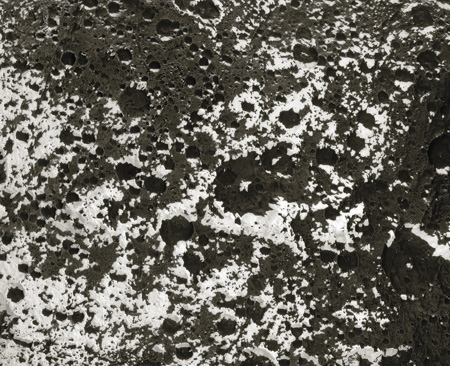
|
2004/05 — Discovery of the Equatorial Ridge and Cassini’s ‘B/C’ Flyby
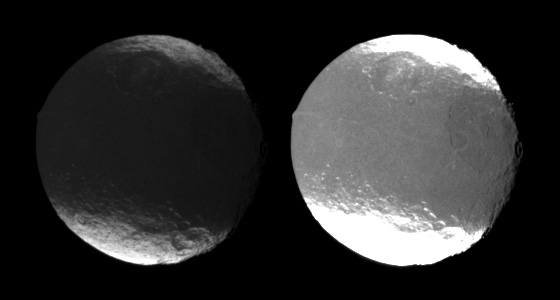 The image at upper right shows the discovery image of the equatorial ridge, taken by the Cassini spacecraft on 25 Dec 2004 (half a day after release of the Huygens probe). The right panel shows the same image, but contrast enhanced to improve the visibility of structure within the dark Cassini Regio. The ridge can be clearly seen and follows exactly along Iapetus’ equator. Thus, it is not only a geological, but also a geographical feature. Although several formation scenarios have been proposed, there is no general consensus, and the origin of the ridge remains unknown.
The image at upper right shows the discovery image of the equatorial ridge, taken by the Cassini spacecraft on 25 Dec 2004 (half a day after release of the Huygens probe). The right panel shows the same image, but contrast enhanced to improve the visibility of structure within the dark Cassini Regio. The ridge can be clearly seen and follows exactly along Iapetus’ equator. Thus, it is not only a geological, but also a geographical feature. Although several formation scenarios have been proposed, there is no general consensus, and the origin of the ridge remains unknown.
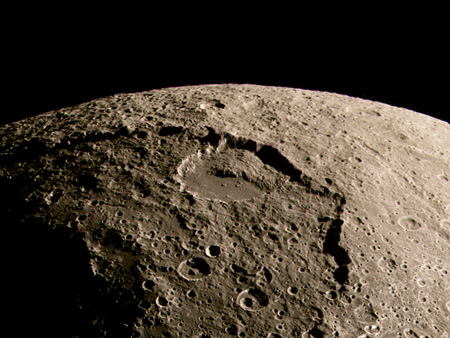 One week later, the second-closest Iapetus approach of Cassini ever brought the spacecraft to a minimum altitude of 122600 km. (It was nicknamed the ‘B/C’ flyby because it occured at the boundary of the Cassini orbits around Saturn labeled ‘B’ and ‘C’.) On 31 Dec 2004 and 01 Jan 2005, data of Iapetus were taken over the course of two days. The image at lower right was obtained during the ‘B/C’ flyby and shows a giant landslide within crater Malun (diameter 120 km), which is located at the edge of Turgis, the largest well preserved basin on Iapetus (580 km diameter). Malun and Turgis are also visible in the image from 25 Dec.
One week later, the second-closest Iapetus approach of Cassini ever brought the spacecraft to a minimum altitude of 122600 km. (It was nicknamed the ‘B/C’ flyby because it occured at the boundary of the Cassini orbits around Saturn labeled ‘B’ and ‘C’.) On 31 Dec 2004 and 01 Jan 2005, data of Iapetus were taken over the course of two days. The image at lower right was obtained during the ‘B/C’ flyby and shows a giant landslide within crater Malun (diameter 120 km), which is located at the edge of Turgis, the largest well preserved basin on Iapetus (580 km diameter). Malun and Turgis are also visible in the image from 25 Dec.
![]() Porco, C.C., E. Baker, J. Barbara, K. Beurle, A. Brahic, J.A. Burns, S. Charnoz, N. Cooper, D.D. Dawson, A.D. DelGenio, T. Denk, L. Dones, U. Dyudina, M.W. Evans, B. Giese, K. Grazier, P. Helfenstein, A.P. Ingersoll, R.A. Jacobson, T.V. Johnson, A.S. McEwen, C.D. Murray, G. Neukum, W.M. Owen, J. Perry, T. Roatsch, J. Spitale, S.W. Squyres, P.C. Thomas, M. Tiscareno, E.P. Turtle, A.R. Vasavada, J. Veverka, R. Wagner, and R. West (2005): Cassini Imaging Science: Initial Results on Phoebe and Iapetus. Science 307, 1237-1242. doi:10.1126/science.1107981.
Porco, C.C., E. Baker, J. Barbara, K. Beurle, A. Brahic, J.A. Burns, S. Charnoz, N. Cooper, D.D. Dawson, A.D. DelGenio, T. Denk, L. Dones, U. Dyudina, M.W. Evans, B. Giese, K. Grazier, P. Helfenstein, A.P. Ingersoll, R.A. Jacobson, T.V. Johnson, A.S. McEwen, C.D. Murray, G. Neukum, W.M. Owen, J. Perry, T. Roatsch, J. Spitale, S.W. Squyres, P.C. Thomas, M. Tiscareno, E.P. Turtle, A.R. Vasavada, J. Veverka, R. Wagner, and R. West (2005): Cassini Imaging Science: Initial Results on Phoebe and Iapetus. Science 307, 1237-1242. doi:10.1126/science.1107981.
![]()
![]()
1980/81 — Distant Flybys of the Voyager Spacecraft
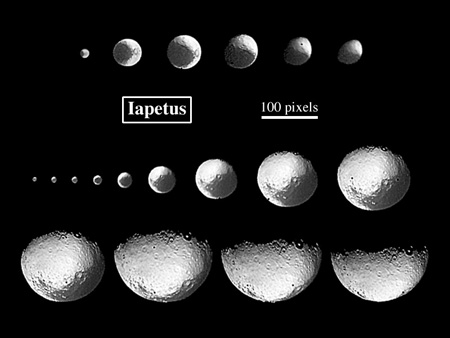 In November 1980 and August 1981, the uncrewed NASA spacecraft Voyager 1 and Voyager 2 obtained the first disk-resolved images of Iapetus ever during their travels through the Saturn system. The best spatial resolution was 9 km/pixel.
In November 1980 and August 1981, the uncrewed NASA spacecraft Voyager 1 and Voyager 2 obtained the first disk-resolved images of Iapetus ever during their travels through the Saturn system. The best spatial resolution was 9 km/pixel.
The image composite at right shows all perspectives where Voyager 1 and 2 observed Iapetus.
Top row: Voyager 1 images, showing the northern sub-Saturn and leading hemisphere; closest approach was on 15 Nov 1980 at a distance of 25 million km.
Both bottom rows: Voyager 2 images; anti-Saturn side and north-polar area; closest approach on 23 Aug 1981 at 910000 km. The large dark terrain on the leading side was named Cassini Regio in honor of the discoverer of Iapetus.
1879 — Photometric Lightcurve of Iapetus
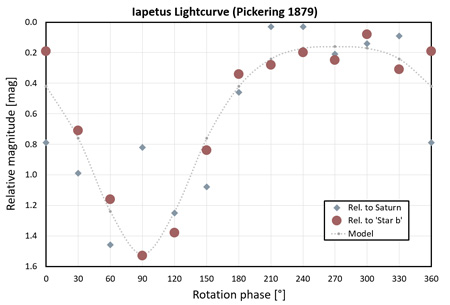 While the fact of Iapetus’ strong brightness variation was known since 200 years, it was quantitatively measured for the first time in fall 1877 with a photometer at Harvard Observatory. For this purpose, the light of Iapetus was measured relative to Saturn and relative to a star of similar brightness (labelled “Star b” in Pickering et al. 1879). Note that, in the 19th century, the final evaluation of an equality of two light sources took place by the human eye. Electrical or chemical intensity measurements with a phototube or through photography were not yet available for faint light sources. The best measurement accuracy was about ±0.1 magnitudes; or about ±0.05 mag if the mean of several measurements was taken.
While the fact of Iapetus’ strong brightness variation was known since 200 years, it was quantitatively measured for the first time in fall 1877 with a photometer at Harvard Observatory. For this purpose, the light of Iapetus was measured relative to Saturn and relative to a star of similar brightness (labelled “Star b” in Pickering et al. 1879). Note that, in the 19th century, the final evaluation of an equality of two light sources took place by the human eye. Electrical or chemical intensity measurements with a phototube or through photography were not yet available for faint light sources. The best measurement accuracy was about ±0.1 magnitudes; or about ±0.05 mag if the mean of several measurements was taken.
The plot to the upper right is a visualization of Table LI in Pickering et al. (1879), showing Iapetus’ relative magnitude over rotational phase (binned to 30° steps). (Interestingly, Pickering did not include such a figure in his report, just the table.) Zero degrees corresponds to the Saturn-facing side of Iapetus (superior conjunction), 90° to the dark leading side (eastern elongation), 180° to the anti-Saturn side (inferior conjunction), and 270° to the bright trailing side (western elongation). More lightcurves of Iapetus were taken later: 1896-1900 (Wendell and Pickering 1913); 1905-1912 (Guthnick 1910, 1914), 1922 (Graff 1939), 1949 (Widorn 1950), 1951-1953 (Harris 1961), and 1970-1974 (Millis 1973; Andersson 1974; Noland 1974; Franklin and Cook 1974). All were proving the symmetry of the lightcurve and that the minimum coincides with the center of Iapetus’ apex of motion.
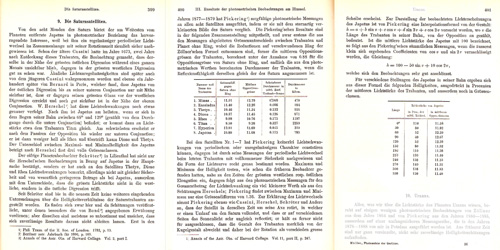 The book “Photometrie der Gestirne” (means: the photometry of celestial bodies) by Gustav Müller gives a good summary of photometric work about Iapetus (and other Saturnian moons) from Cassini until Pickering. The figure at right provides a scan of the three related pages (in German).
The book “Photometrie der Gestirne” (means: the photometry of celestial bodies) by Gustav Müller gives a good summary of photometric work about Iapetus (and other Saturnian moons) from Cassini until Pickering. The figure at right provides a scan of the three related pages (in German). ![]() Das Buch “Photometrie der Gestirne” von Gustav Müller gibt eine gute Zusammenfassung zur Photometrie von Iapetus (und anderen Saturnmonden) von Cassini bis Pickering. Das Bild rechts zeigt die entsprechenden Seiten in Müllers Werk.
Das Buch “Photometrie der Gestirne” von Gustav Müller gibt eine gute Zusammenfassung zur Photometrie von Iapetus (und anderen Saturnmonden) von Cassini bis Pickering. Das Bild rechts zeigt die entsprechenden Seiten in Müllers Werk.
![]() Pickering, E.C., Searle, A., Upton, W. (1879): Photometric Observations. Part II, Chapter IX: Satellites of Saturn. Annals of Harvard College Observatory 11, 247-270. (pdf → here)
Pickering, E.C., Searle, A., Upton, W. (1879): Photometric Observations. Part II, Chapter IX: Satellites of Saturn. Annals of Harvard College Observatory 11, 247-270. (pdf → here)
![]() Müller, G. (1897): Die Photometrie der Gestirne. Verlag von Wilhelm Engelmann, Leipzig, 556 Seiten. [pdf-File, 35,4 Mb → hier; Unterkapitel ‘Saturnmonde’ → hier]
Müller, G. (1897): Die Photometrie der Gestirne. Verlag von Wilhelm Engelmann, Leipzig, 556 Seiten. [pdf-File, 35,4 Mb → hier; Unterkapitel ‘Saturnmonde’ → hier]
![]() Guthnick, P. (1910): Ergebnisse aus photometrischen Messungen der Saturntrabanten. 1. Über den Lichtwechsel des Japetus. Beobachtungs-Ergebnisse der Königlichen Sternwarte zu Berlin, No. 14, H. Struwe (Hrsg.), Ferd. Dümmlers Verlagsbuchhandlung, Berlin 1910, 75 Seiten.
Guthnick, P. (1910): Ergebnisse aus photometrischen Messungen der Saturntrabanten. 1. Über den Lichtwechsel des Japetus. Beobachtungs-Ergebnisse der Königlichen Sternwarte zu Berlin, No. 14, H. Struwe (Hrsg.), Ferd. Dümmlers Verlagsbuchhandlung, Berlin 1910, 75 Seiten.
![]() Wendell, O.C., Pickering, E.C. (1913): Observations of Satellites of Saturn. Annals of the Astronomical Observatory of Harvard College 69, Part 2, Chapter XII, 218-225. [See also Andersson 1974, Fig. 25, for a graphical reproduction of this Iapetus lightcurve.]
Wendell, O.C., Pickering, E.C. (1913): Observations of Satellites of Saturn. Annals of the Astronomical Observatory of Harvard College 69, Part 2, Chapter XII, 218-225. [See also Andersson 1974, Fig. 25, for a graphical reproduction of this Iapetus lightcurve.]
![]() Guthnick, P. (1914): Die veränderlichen Satelliten des Jupiter und Saturn. Astronomische Nachrichten 198, 233-256.
Guthnick, P. (1914): Die veränderlichen Satelliten des Jupiter und Saturn. Astronomische Nachrichten 198, 233-256.
![]() Graff, K. (1939): Der Lichtwechsel der Saturntrabanten Titan und Japetus im Jahre 1922. Aus: Sitzungsberichte der Österreichischen Akademie der Wissenschaften, Math.-nat. Kl. IIa, 148, S. 49-57 (vorgelegt in der Sitzung am 02 Feb 1939). [See also Andersson 1974, Fig. 27, for a graphical reproduction of this Iapetus lightcurve.]
Graff, K. (1939): Der Lichtwechsel der Saturntrabanten Titan und Japetus im Jahre 1922. Aus: Sitzungsberichte der Österreichischen Akademie der Wissenschaften, Math.-nat. Kl. IIa, 148, S. 49-57 (vorgelegt in der Sitzung am 02 Feb 1939). [See also Andersson 1974, Fig. 27, for a graphical reproduction of this Iapetus lightcurve.]
![]() Widorn, T. (1950). Der Lichtwechsel des Saturnsatelliten Japetus im Jahre 1949. Aus: Sitzungsberichte der Österreichischen Akademie der Wissenschaften, Math.-nat. Kl. Abt. IIa, 159, 189-199 (vorgelegt in der Sitzung am 15 Jun 1950). [See also Andersson 1974, Fig. 28, for a graphical reproduction of this Iapetus lightcurve.]
Widorn, T. (1950). Der Lichtwechsel des Saturnsatelliten Japetus im Jahre 1949. Aus: Sitzungsberichte der Österreichischen Akademie der Wissenschaften, Math.-nat. Kl. Abt. IIa, 159, 189-199 (vorgelegt in der Sitzung am 15 Jun 1950). [See also Andersson 1974, Fig. 28, for a graphical reproduction of this Iapetus lightcurve.]
![]() Harris, D.L. (1961): Photometry and Colorimetry of Planets and Satellites. Chapter 8 in Planets and Satellites (Kuiper, G.P., Middlehurst, B.M., eds), Univ. of Chicago Press, Chicago.
Harris, D.L. (1961): Photometry and Colorimetry of Planets and Satellites. Chapter 8 in Planets and Satellites (Kuiper, G.P., Middlehurst, B.M., eds), Univ. of Chicago Press, Chicago.
![]() Millis, R.L. (1973): UBV Photometry of Iapetus. Icarus 18, 247-252.
Millis, R.L. (1973): UBV Photometry of Iapetus. Icarus 18, 247-252.
![]() Andersson, L.E. (1974): A Photometric Study of Pluto and Satellites of the Outer Planets. Ph.D-Thesis, Inidana University, 226 p.
Andersson, L.E. (1974): A Photometric Study of Pluto and Satellites of the Outer Planets. Ph.D-Thesis, Inidana University, 226 p.
![]() Noland, M., Veverka, J., Morrison, D., Cruikshank, D.P., Lazarewicz, A.R., Morrison, N.D., Elliot, J.L., Goguen, J., Burns, J.A. (1974): Six Color Photometry of Iapetus, Titan, Rhea, Dione, and Tethys. Icarus 23, 334-354.
Noland, M., Veverka, J., Morrison, D., Cruikshank, D.P., Lazarewicz, A.R., Morrison, N.D., Elliot, J.L., Goguen, J., Burns, J.A. (1974): Six Color Photometry of Iapetus, Titan, Rhea, Dione, and Tethys. Icarus 23, 334-354.
![]() Franklin, F.A., Cook, A.F. (1974): Photometry of Saturn‘s Satellites: The Opposition Effect of Iapetus at Maximum Light and the Variability of Titan. Icarus 23, 355-362.
Franklin, F.A., Cook, A.F. (1974): Photometry of Saturn‘s Satellites: The Opposition Effect of Iapetus at Maximum Light and the Variability of Titan. Icarus 23, 355-362.
![]() Morrison, D., Jones, T.J., Cruikshank, D.P., Murphy, R.E. (1975): The Two Faces of Iapetus. Icarus 24, 157-171.
Morrison, D., Jones, T.J., Cruikshank, D.P., Murphy, R.E. (1975): The Two Faces of Iapetus. Icarus 24, 157-171.
1671-77 — Discovery of Iapetus and of the Global Brightness Dichotomy
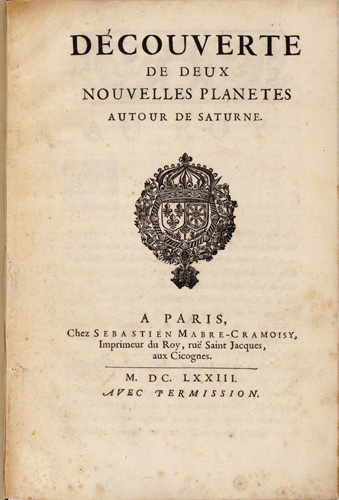 Jean-Dominique Cassini, astronomer at the court of Louis XIV and director of the newly founded Paris Observatory, discovered four satellites of Saturn. His first discovery was Iapetus on 25 Oct 1671. During the following months and years, Cassini could see Iapetus only while this moon was located west of Saturn, but never on the other side. He correctly concluded that this object must have a dark and a bright hemisphere. Related publications by J.D. Cassini in French, English, and Italian are listed below. Note that the name Iapetus was given to this moon only 176 years later.
Jean-Dominique Cassini, astronomer at the court of Louis XIV and director of the newly founded Paris Observatory, discovered four satellites of Saturn. His first discovery was Iapetus on 25 Oct 1671. During the following months and years, Cassini could see Iapetus only while this moon was located west of Saturn, but never on the other side. He correctly concluded that this object must have a dark and a bright hemisphere. Related publications by J.D. Cassini in French, English, and Italian are listed below. Note that the name Iapetus was given to this moon only 176 years later.
![]() Cassini, J.D. (1673): Découverte de deux nouvelles planètes autour de Saturne. Fol. chez Sébastien Mabre-Cramoisy, Imprimeur du Roy, Paris, pp. 5-14 + 5 figures. (Fichier pdf: ici)
Cassini, J.D. (1673): Découverte de deux nouvelles planètes autour de Saturne. Fol. chez Sébastien Mabre-Cramoisy, Imprimeur du Roy, Paris, pp. 5-14 + 5 figures. (Fichier pdf: ici)
![]() Cassini, J.D. (1673): A Discovery of Two New Planets about Saturn, Made in the Royal Parisian Observatory by Signor Cassini, Fellow of Both the Royal Societys, of England and France; English’t Out of French. Philosophical Transactions Vol. 8, No. 92, 5178-5185 (25 Mar 1673). doi:10.1098/rstl.1673.0003.
Cassini, J.D. (1673): A Discovery of Two New Planets about Saturn, Made in the Royal Parisian Observatory by Signor Cassini, Fellow of Both the Royal Societys, of England and France; English’t Out of French. Philosophical Transactions Vol. 8, No. 92, 5178-5185 (25 Mar 1673). doi:10.1098/rstl.1673.0003.
![]() Cassini, J.D. (1677): Histoire de la Découverte de deux Planetes autour de Saturne, faite à l’Observatoire Royal par M. Cassini. Journal des Sçavans, No. VI, 70-72 (15. Mars 1677).
Cassini, J.D. (1677): Histoire de la Découverte de deux Planetes autour de Saturne, faite à l’Observatoire Royal par M. Cassini. Journal des Sçavans, No. VI, 70-72 (15. Mars 1677).
![]() Cassini, J.D. (1677): Some New Observations Made by Sig. Cassini and Deliver’d in the Journal Des Scavans, Concerning the Two Planets about Saturn, Formerly Discover’d by the Same, as Appears in N. 92. of these Tracts. Philosophical Transactions Vol. 12, No. 133, 831-833 (25 Mar 1677). doi:10.1098/rstl.1677.0004.
Cassini, J.D. (1677): Some New Observations Made by Sig. Cassini and Deliver’d in the Journal Des Scavans, Concerning the Two Planets about Saturn, Formerly Discover’d by the Same, as Appears in N. 92. of these Tracts. Philosophical Transactions Vol. 12, No. 133, 831-833 (25 Mar 1677). doi:10.1098/rstl.1677.0004.
![]() Cassini, J.D. (1677): Estratto di alcu ne osseru azione portate nel VI. Giornals di Francia 1677. Il Giornale de Letterati, No. VI, 92-93.
Cassini, J.D. (1677): Estratto di alcu ne osseru azione portate nel VI. Giornals di Francia 1677. Il Giornale de Letterati, No. VI, 92-93.
![]() Deutschlandfunk — Kalenderblatt 25 Okt 2021: Vor 350 Jahren entdeckt: Giovanni Domenico Cassini und der Saturnmond Iapetus.
Deutschlandfunk — Kalenderblatt 25 Okt 2021: Vor 350 Jahren entdeckt: Giovanni Domenico Cassini und der Saturnmond Iapetus.

© Tilmann Denk (2025)

